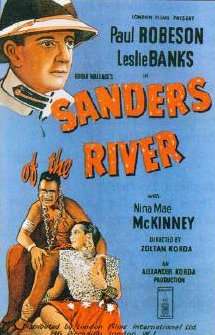Sanders of the River
| Sanders of the River Alternate title: Bosambo | |
|---|---|
 Film poster | |
| Directed by | Zoltán Korda |
| Produced by | Alexander Korda |
| Written by |
Lajos Bíró Jeffrey Dell Edgar Wallace Arthur Wimperis |
| Starring |
Leslie Banks Paul Robeson |
| Cinematography |
Osmond Borradaile Louis Page Georges Périnal |
| Edited by | Charles Crichton |
Release dates |
|
Running time | 98 minutes |
| Country | United Kingdom |
| Language | English |
Sanders of the River is a 1935 British film directed by the Hungarian-British director, Zoltán Korda, based on the stories of Edgar Wallace. It is set in British Nigeria. The lead Nigerian characters were played by African-Americans Paul Robeson and Nina Mae McKinney.The film proved a significant commercial and critical success, giving Korda the first of his four nominations for Best Film at the Venice Film Festival.
Plot
Sanders (Leslie Banks) is a British colonial District Commissioner in Colonial Nigeria. He tries to rule his province fairly, including the various tribes comprising the Peoples of the River. He is regarded with respect by some and with fear by others, among whom he is referred to as "Sandi" and "Lord Sandi". He has an ally in Bosambo, a literate and educated chief (played by the American actor, Paul Robeson).
When Sanders goes on leave, another chief, King Mofolaba, spreads the rumour that "Sandi is dead." Intertribal war seems inevitable, and the situation is made worse by gun-runners and slavers.
His relief, Ferguson (known to the natives as Lord Ferguson), is unequal to the task; he is captured and killed by King Mofolaba. Sanders returns to restore peace. When Bosambo's wife Lilongo (Nina Mae McKinney) is kidnapped, the chief tracks down her kidnappers. Captured by them, he is saved by a relief force commanded by Sanders. Bosambo kills King Mofolaba and is subsequently named by Sanders as the King of the Peoples of the River.
Cast
- Leslie Banks as Commissioner R.G. Sanders
- Paul Robeson as Bosambo
- Nina Mae McKinney as Lilongo
- Martin Walker as J. Ferguson
- Robert Cochran as Lieutenant Tibbets (as Robert Cochrane)
- Richard Grey as Captain Hamilton
- Toto Ware as King Mofolaba
- Marqués De Portago as Farini
- Eric Maturin as Smith
- Allan Jeayes as Father O'Leary
- Charles Carson as Sir John
- Jomo Kenyatta as Tribal Leader
Colonia administrator Sir B. Bourdillon is credited as an adviser.
Paul Robeson disowns the film

The African-American singer and actor Paul Robeson, a civil rights activist, accepted the role of Bosambo while living in London. At the time, he was studying the roots of pan-African culture through studies of language and music. He felt that if he could portray the Nigerian leader, Bosambo, with cultural accuracy and dignity, he could help audiences—especially Black audiences—to understand and respect the roots of Black culture. He took the role on the condition that the film would portray Africans positively.
The filmmakers took an unusual step towards authenticity by sending a film crew on a four-month voyage into remote areas of the African continent. They recorded traditional African dances and ceremonies, with the intention of using this footage integrated with scenes shot in the studio that included the future President and Prime Minister of Kenya Jomo Kenyatta as one of the extras.[1]
After the filming, Robeson was asked back to the studio for retakes of some scenes. He discovered that the film’s message had been changed during editing; it seemed to justify imperialism and upholding the "White Man's Burden." The finished film was dedicated to "the handful of white men whose everyday work is an unsung saga of courage and efficiency".[2]
Bosambo was changed from a Nigerian leader to a servile lackey of British colonial rule. Robeson was furious and complained:
The imperialist plot had been placed in the plot during the last days five days of shooting...I was roped into the picture because I wanted to portray the culture of the African people and I committed a faux pas which convinced me that I had failed to weigh the problems of 150,000,000 native Africans...I hate the picture.[3]
In 1938, Robeson added disparagingly: "It is the only film of mine that can be shown in Italy or Germany, for it shows the negro as Fascist states desire him - savage and childish."[4]
Robeson was so disillusioned by the picture that he attempted, but failed, to buy back all the prints to prevent it from being shown.[5]
Other versions
The film was soon parodied in Will Hay's film Old Bones of the River (1938). This comedy featured the characters named Commissioner Sanders, Captain Hamilton and Bosambo, but different actors played the parts and the script was changed. This film was described as "the most comprehensive trashing of the British Empire ever put on celluloid."[6]
In 1963 producer Harry Alan Towers made a German/British international co-production small scale version of the film, Death Drums Along the River set in the modern day only using some of the names of the characters.
References
- ↑ pp. 199-200 Neame, Ronald with Cooper, Barbara Roisman Straight from the Horse's Mouth: Ronald Neame, an Autobiography Scarecrow Press, 27/09/2003
- ↑ "Korda and Empire", BFI screenonline page
- ↑ Duberman, Martin, Paul Robeson: The Discovery of Africa, 1989, p. 182.
- ↑ Duberman (1989), Paul Robeson, p. 180.
- ↑ Robeson, Susan, A Pictorial Biography of Paul Robeson: The Whole World in His Hands, 1981, p. 73.
- ↑ "British Films of the 30s, 40s and 50s", British Pictures website
External links
- Sanders of the River at the Internet Movie Database
- Sanders of the River at AllMovie (Alternate title: Bosambo)